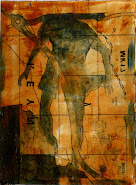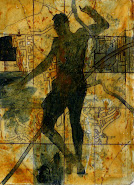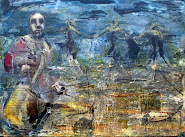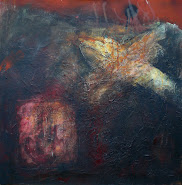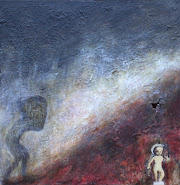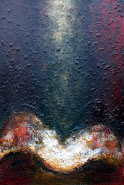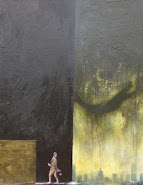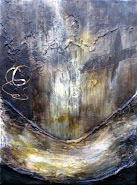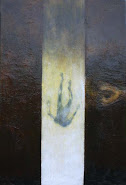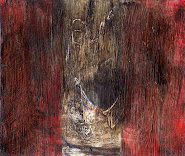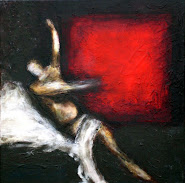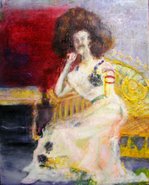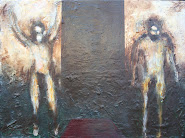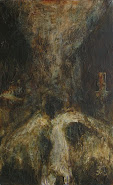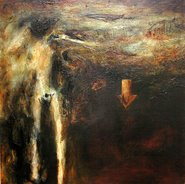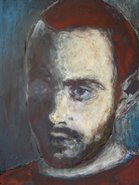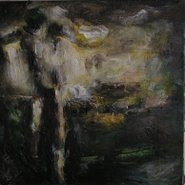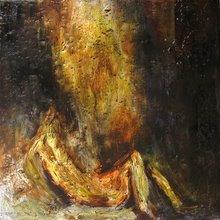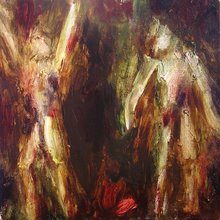Our Artwork
Saturday, 9 February 2008
www.whalecrow.co.uk
We were getting a bit crapped on here, so we have moved home. If you would like to come along to see where we now live then visit... www.whalecrow.co.uk. This will now be our permanent recidence
Sunday, 20 January 2008
Responding to your troubles
I was reading what you wrote a few days ago, it seems to me that you're falling for the same trap and over thinking again, I know that what you wrote was fairly loose and not necessarily defining anything but it still is placing these thoughts into words which has a limiting, categorising effect. The main problem you seem to have is separating your critical practice/learning from the artistic, so it may be wise to simply collect those visual images you find interesting and arrange them in ways that strike a chord, not a literary chord but just a feeling that they're right together. this way you'll find other allusions may occur that actually end up meaning more to you. whether this is any use to you i don;t know.
Saturday, 19 January 2008
Exclusive 10%-15%
Exclusive
quit
act slump
Fear
risk
One big property
shut doors withdraw
yesterday slump
panic seilling
move fears North-
run on
once high-fly
seen a safe haven
the on
sh, quit yesterday
all invest
fund able access
for a year.
the giant fund
in office blocks and shopping
centres across Britain, no longer
reserve meet demand
withdraw
money. down to
total ass the usual
10%-15%
quit
act slump
Fear
risk
One big property
shut doors withdraw
yesterday slump
panic seilling
move fears North-
run on
once high-fly
seen a safe haven
the on
sh, quit yesterday
all invest
fund able access
for a year.
the giant fund
in office blocks and shopping
centres across Britain, no longer
reserve meet demand
withdraw
money. down to
total ass the usual
10%-15%
Wednesday, 16 January 2008
Broken thoughts
lack of sleep
drowning in paperwork and struggling to fit tasks to time
stressing about my practise.
Your text about MAtthias WEischer (sp) , looking at some Rauschenburgand a re read of Gunter Grass (sp) have got me thinking. I am having flickers of what I want my work to start doing in my head but feel frsutrated an its intangibility.
I know I want to start drawing things from many sources which create mini narratives with underlying meta narratives, allegories if you like. I know maps, art historcial references, various painterly marks, figures in general, text, gridsa and lines of perspective, architecture, small elements of illustration of 'objets', floating, falling and submerged forms... I know I want all of these to come together to form poetic narratives. Where elements draw us beneath the surface and other pull us back across. Where meaning seems both intense and allusive, where we can flicker between a multiplicity of potential conclusions- where there are basically painterly, spatial, pictorial and analytical disjunctions. (fuck knows if I know what I mean)
I want to create the kind of feel we have when we skip between elements on the internet, or when we slip through memoreis in our head. i want it to be about now but equally to be about issues of time, concenrs of histories, elements of the sefl indulgent personal, touches of the purely formal, to be both concise and articualte whilst also utterly non sensiscal. To be romantic but pragmmatic, to be everything adn nothing. To have lose, time, tragedy, rise and fall, transcedence and witt all rolled up together like a sweet which can be quickly consummed but then makes you vomit up your insides.
At the moment though, im worrying due to not having painted for a few days. I am created small, weakly paintede, pretentious, pastiche and meaningless little scribbles. I am progressing but now way near getting close to this undescribable thing I am chasing. And now I am on heere when I shold be compleing a lecture plan and constructing paragraphs and sentences which are confussing me more than helping me.
I really wish i did not care about all this pointless crap- but it keep knocking at my head
drowning in paperwork and struggling to fit tasks to time
stressing about my practise.
Your text about MAtthias WEischer (sp) , looking at some Rauschenburgand a re read of Gunter Grass (sp) have got me thinking. I am having flickers of what I want my work to start doing in my head but feel frsutrated an its intangibility.
I know I want to start drawing things from many sources which create mini narratives with underlying meta narratives, allegories if you like. I know maps, art historcial references, various painterly marks, figures in general, text, gridsa and lines of perspective, architecture, small elements of illustration of 'objets', floating, falling and submerged forms... I know I want all of these to come together to form poetic narratives. Where elements draw us beneath the surface and other pull us back across. Where meaning seems both intense and allusive, where we can flicker between a multiplicity of potential conclusions- where there are basically painterly, spatial, pictorial and analytical disjunctions. (fuck knows if I know what I mean)
I want to create the kind of feel we have when we skip between elements on the internet, or when we slip through memoreis in our head. i want it to be about now but equally to be about issues of time, concenrs of histories, elements of the sefl indulgent personal, touches of the purely formal, to be both concise and articualte whilst also utterly non sensiscal. To be romantic but pragmmatic, to be everything adn nothing. To have lose, time, tragedy, rise and fall, transcedence and witt all rolled up together like a sweet which can be quickly consummed but then makes you vomit up your insides.
At the moment though, im worrying due to not having painted for a few days. I am created small, weakly paintede, pretentious, pastiche and meaningless little scribbles. I am progressing but now way near getting close to this undescribable thing I am chasing. And now I am on heere when I shold be compleing a lecture plan and constructing paragraphs and sentences which are confussing me more than helping me.
I really wish i did not care about all this pointless crap- but it keep knocking at my head
Thursday, 10 January 2008
Rain sketch
She was a wet veil
Which quenched the roads thirst
Puddling and eating yesterdays memories
Footprints drowned in browning milk
She was those falling dancers
Rhythmically breaking and spraying across that screen
Window to wall and a road lost in a haze of beauty
She was rivers running down your face
Heavy feet and an oh so slow journey
Slippers by the fire just a mirage
Which quenched the roads thirst
Puddling and eating yesterdays memories
Footprints drowned in browning milk
She was those falling dancers
Rhythmically breaking and spraying across that screen
Window to wall and a road lost in a haze of beauty
She was rivers running down your face
Heavy feet and an oh so slow journey
Slippers by the fire just a mirage
Tuesday, 8 January 2008
A couple of poems and a diary entry
Lemon Twist
Ever seen a lemon
Twisted by one juicer?
Its flesh dissect then disintegrate.
Lap it up
The bitter life's-blood
That slides over your skin
Like Archimedes through your mind.
Lap it up
It stinks.
A Short Trip Up The Ganges With Graeme Greene
Your rose-hipped fella there
With wistful eye's and scruffy hair
Looks all fine, flippant and fair.
But he's a thin jonny two-bob,
A paddler true.
Doesn't stick his oars in right,
Doesn't look to you.
And when you look to him
Through his mane of sunship flip
As the needle-point stitched light
Turns to sulphurous green night,
And his leprous diamond trumpitt
Doesn't sound quite so bright.
When his hessian filled mouth
Fails to ignite...
...Would you look to your feet?
Observe a stench quite oblique?
That stirs a memory quite unique.
And see my snivelling, repugnant mass
Still resides there repleat.
On the subject of poems, have you read any T.S.Eliot, specifically his wasteland poems? I'm thinking in particular of A lovesong to Arthur J. Pruefrock. I may have got that wrong but its something similar. That poem was a revelation to me, its astonishing. I'll try to remember to bring it with me when i come down.
Diary entry 07/01/08
What type career artist do i want to be? I always have the most respect for an artist who seems ambivalent to current trends, an artist who bravely trudges his own path. I am thinking here of examples such as David Hockney and Auerbach. Their practices are poles apart, Auerbach has been stoically banging his head against the same wall for 40yrs or more, whilst Hockney, like a hummingbird has flitted from one area of concern to the next in a never ending search for... well... everything. However they both seem to transcend the earthly problem of style (style being associated with fashion here). This I can see as being a slightly naive statement, particularly with regard to their early careers, both were certainly aware of the artscene around them, however, they never seemed defined by it, yet, particularly with Hockney, the work has for the most part appeared current. I think this is the area that this entry has moved into now, how do you create art that matters (that has the appearence of being culturally relevant) whilst not falling into a dogmatic copy-cat of current styles? To remain true to yourself doesn't seem to quite cut it, what exactly is true to yourself? It doesn't exist because we are a product of our time and environment. So again it seems to be a balancing act, perhaps this is thereason why artists are naturally wary of power structures, governments and such, because it thus places us on the outside of something giving us just a bit of objective space in order to find our voice, a voice that whilst heavily influenced by society is not totally reliant upon society. That said, I'm stuck in my parents house in the fog of middle-class suburbia, i'm kinda failing miserably in my efforts to see anything.
Ever seen a lemon
Twisted by one juicer?
Its flesh dissect then disintegrate.
Lap it up
The bitter life's-blood
That slides over your skin
Like Archimedes through your mind.
Lap it up
It stinks.
A Short Trip Up The Ganges With Graeme Greene
Your rose-hipped fella there
With wistful eye's and scruffy hair
Looks all fine, flippant and fair.
But he's a thin jonny two-bob,
A paddler true.
Doesn't stick his oars in right,
Doesn't look to you.
And when you look to him
Through his mane of sunship flip
As the needle-point stitched light
Turns to sulphurous green night,
And his leprous diamond trumpitt
Doesn't sound quite so bright.
When his hessian filled mouth
Fails to ignite...
...Would you look to your feet?
Observe a stench quite oblique?
That stirs a memory quite unique.
And see my snivelling, repugnant mass
Still resides there repleat.
On the subject of poems, have you read any T.S.Eliot, specifically his wasteland poems? I'm thinking in particular of A lovesong to Arthur J. Pruefrock. I may have got that wrong but its something similar. That poem was a revelation to me, its astonishing. I'll try to remember to bring it with me when i come down.
Diary entry 07/01/08
What type career artist do i want to be? I always have the most respect for an artist who seems ambivalent to current trends, an artist who bravely trudges his own path. I am thinking here of examples such as David Hockney and Auerbach. Their practices are poles apart, Auerbach has been stoically banging his head against the same wall for 40yrs or more, whilst Hockney, like a hummingbird has flitted from one area of concern to the next in a never ending search for... well... everything. However they both seem to transcend the earthly problem of style (style being associated with fashion here). This I can see as being a slightly naive statement, particularly with regard to their early careers, both were certainly aware of the artscene around them, however, they never seemed defined by it, yet, particularly with Hockney, the work has for the most part appeared current. I think this is the area that this entry has moved into now, how do you create art that matters (that has the appearence of being culturally relevant) whilst not falling into a dogmatic copy-cat of current styles? To remain true to yourself doesn't seem to quite cut it, what exactly is true to yourself? It doesn't exist because we are a product of our time and environment. So again it seems to be a balancing act, perhaps this is thereason why artists are naturally wary of power structures, governments and such, because it thus places us on the outside of something giving us just a bit of objective space in order to find our voice, a voice that whilst heavily influenced by society is not totally reliant upon society. That said, I'm stuck in my parents house in the fog of middle-class suburbia, i'm kinda failing miserably in my efforts to see anything.
Friday, 4 January 2008
Selection of responses
I've been thinking about what you have written about your working practise, about how your paintings are a series of destructions, this is meaning that there is a starting image (photo, historical painting etc) and how your work is about breaking down this image in order to pick out particular parts, enhancing these sections in order to create new meaning (I could splurt out a whole load of verbose chatter about sign and signifier here but i won't).
I am thinking that my own work is about a series of additions onto already semi realised paintings. The photo which is the seed where an idea germinates becomes very quickly, very distant and the aim becomes to build on the created painting a new painting. Building up layers of history that slowly, through the sedementation of truths and semi-truths, into the realm of a new-old mythology.
As for your new works, well i think that it could potentially lead to somewhere very interesting, as for whether the staining that you've done on them makes a significant difference, it does give the impression of something trapped in time, however, i find that side of them slightly obvious. What i think is more exciting are these works of obliterating newspaper images. i've spoken as much as i can about this previously, the challenge for you is how you can translate this to more significant. i think you need to expand upon the single photo image, perhaps starting by collaging a couple of photos together, and responding by oblitering these. i think this could then start to make them mean something more significant.
I am thinking that my own work is about a series of additions onto already semi realised paintings. The photo which is the seed where an idea germinates becomes very quickly, very distant and the aim becomes to build on the created painting a new painting. Building up layers of history that slowly, through the sedementation of truths and semi-truths, into the realm of a new-old mythology.
As for your new works, well i think that it could potentially lead to somewhere very interesting, as for whether the staining that you've done on them makes a significant difference, it does give the impression of something trapped in time, however, i find that side of them slightly obvious. What i think is more exciting are these works of obliterating newspaper images. i've spoken as much as i can about this previously, the challenge for you is how you can translate this to more significant. i think you need to expand upon the single photo image, perhaps starting by collaging a couple of photos together, and responding by oblitering these. i think this could then start to make them mean something more significant.
Monday, 24 December 2007
finished works and a new sketch


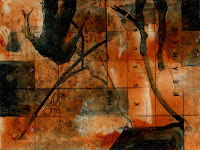

Firstly my apologies. This constant uploading of unfinished works and sketches must be annoying. I think its useful to upload works on the main section though as it allows us to see proper detail.
In regards to this last point...I am having a chat with my sister in how we can restructure this site. I think it serves its current purpose quite well, and we obviously need to be careful not to dedicate to much time and effort to something which is primarily a subsiduary to our work. Having said that, if a few easy(ish) changes can allow it too function, and fullfill our requirements, more sucesfully, than that can only be a good thing.
Anyhow, in regards to uploaded images. The map series 'Between Somewhere and Nowhere' are finished. Having said that, their completion marks the start of a new series of similar works. Anyway, I am happy with them...no need to say anymore than that. For those interested they are about a5 size. They work like thi9s but there is potential for these small paper works to spawn larger canvas works.
The attached sketch is one of the second batch of recent sketches I have done (first batch was uploaded the other day). I am particuarly happy with this sketch. It is called 'Ballet of the Nightingale'. To an extent the title can be ignored, I merely name them at this stage to provide identification for myself. Having said that, the titles do provide an idication of certina elements of content. I am interested in how what were previously seperate elemetns can become one. By that I mean that they are not seperate figures by a single figure at various stages. Or perhaps not, maybe its something vaguer. Fuck knows actually. I don't think I overly need to klnow at this point, these are designed to inform future works, not to be finalised works of clarity.
That said I tihnk the following is true: treat all sketches like major works and all major works like sketches. So the former can have the seriousness of the later and the later the freedome of the former. Or something like that. How depresingly simplisitc and didactic of me.
Merry Christmas.
Sunday, 23 December 2007
Your new work
Right well i had a load of waffle prepared, but then you wrote your last blog and it made me change my mind so i'm unsure whether i need to put it down now.... hmmm..... i think i will, unchanged so that it gives an idea of what i originally thought.
Your last post really helped to raise some pertinent issues with regards to both of our practices. First of all i'll respond to your work (the receipt work), i think it looks like the most contemporary pieces you've made to date, but i don't know what i feel about them, i don't really know what you're trying to say. Perhaps they are somewhere on the way to making a poignant point but for my tastes they're a bit clinical. they seemto be saying something about the figures you're interested in, falling, and thus between states of mind, particularly when placed alongside maps. but this is my quarrel, they "say" these things, linguistically. I'm thinking here of mike lill's degree pieceand how it succeeded in doing some of the things that these pieces of your's are just falling short of. It made me feel as well as think of being inbetween physical and psychological states. However i am glad that you stopped titling your work after classical characters, particularly when baring in mind what you have said about not having clear narratives.
I think there is a lot of potential in this new direction (the newest biro pieces, i believe are another step forward along this line, in fact i'd say that these really are interesting and have a lot more potential in breadth of meaning where the earlier ones are limited). Yet looking at the work has made me realise how difficult it is to unify these techniques that you are employing. I think you should look at gordon cheung's work, he paints enormous apocalyptic landscapes on top of financial times records. I think what he does is a lot simpler than what you're attempting in terms of context and subject but you may learn a lot by looking at his stuff.
What you have been saying has brought me back to looking at gerhard richter's 'the daily practise of painting'. last time i read this was in first year of uni, and if you've not read it you really should consider doing so, its basically the everyday diary of a painter. In the preface it is mentioned how different artists have used writing in different ways to inform their practise, barnett newman's major works were preceded by a lengthy period of writing, hans hoffmans was a didactic impulse, whereas richters runs parallel to the act of painting, accompanies it, questions it and is corrected by it. I found this knowledge to be extremely eye opening, i suppose because it puts the brakes on our bombastic pontificating about how we should use writing for our practice. there is, rather obviously, no correct way of accompanying the work, only what is right for the individual.
here's an extract from his writing. "strange though this may sound, not knowing where one is going - being lost, being a loser - reveals the greatest possible faith and optimism, as against collective security and collective significance. to believe, one must have lost god; to paint, one must have lost art"
i love this quote and suspect that whether you're conscious of it or not, i think you're attempting this exact process, in a way, to lose the shackles of your burgeoning knowledge and empty out your style. maybe thats codswallope.
Your last post really helped to raise some pertinent issues with regards to both of our practices. First of all i'll respond to your work (the receipt work), i think it looks like the most contemporary pieces you've made to date, but i don't know what i feel about them, i don't really know what you're trying to say. Perhaps they are somewhere on the way to making a poignant point but for my tastes they're a bit clinical. they seemto be saying something about the figures you're interested in, falling, and thus between states of mind, particularly when placed alongside maps. but this is my quarrel, they "say" these things, linguistically. I'm thinking here of mike lill's degree pieceand how it succeeded in doing some of the things that these pieces of your's are just falling short of. It made me feel as well as think of being inbetween physical and psychological states. However i am glad that you stopped titling your work after classical characters, particularly when baring in mind what you have said about not having clear narratives.
I think there is a lot of potential in this new direction (the newest biro pieces, i believe are another step forward along this line, in fact i'd say that these really are interesting and have a lot more potential in breadth of meaning where the earlier ones are limited). Yet looking at the work has made me realise how difficult it is to unify these techniques that you are employing. I think you should look at gordon cheung's work, he paints enormous apocalyptic landscapes on top of financial times records. I think what he does is a lot simpler than what you're attempting in terms of context and subject but you may learn a lot by looking at his stuff.
What you have been saying has brought me back to looking at gerhard richter's 'the daily practise of painting'. last time i read this was in first year of uni, and if you've not read it you really should consider doing so, its basically the everyday diary of a painter. In the preface it is mentioned how different artists have used writing in different ways to inform their practise, barnett newman's major works were preceded by a lengthy period of writing, hans hoffmans was a didactic impulse, whereas richters runs parallel to the act of painting, accompanies it, questions it and is corrected by it. I found this knowledge to be extremely eye opening, i suppose because it puts the brakes on our bombastic pontificating about how we should use writing for our practice. there is, rather obviously, no correct way of accompanying the work, only what is right for the individual.
here's an extract from his writing. "strange though this may sound, not knowing where one is going - being lost, being a loser - reveals the greatest possible faith and optimism, as against collective security and collective significance. to believe, one must have lost god; to paint, one must have lost art"
i love this quote and suspect that whether you're conscious of it or not, i think you're attempting this exact process, in a way, to lose the shackles of your burgeoning knowledge and empty out your style. maybe thats codswallope.
Saturday, 22 December 2007
Batch one plus needless waffle

I have done a whole batch now of similar quick sketches to the one in the last post. I am not sure if I have already stated the intention of these sketches, if not then I shall do now. I have have then perhaps this will provide a bit more clarity.
Firstly it should be stated there existence is not explicit in terms of any deep seated meaning. They come from a current desire to manipulate imagery, so are in the purest sense nothing more than an extension of that fascination. They are playful, if you like.
Beyond this I do think they are touching on areas of interest and broadening certainly iconographic potential in my work. I should at least attempt to explain more clearly what I mean by this. Once again, I hope this does not appear to be a justification, more a written clariifcation of the process. I am not sure how much difference there is between those two things.
In terms of broadening areas of interest i suppose I am talking about what we like to call content, subject matter. I know I am increasingly interested in what is found when something else is lost. The construction of images, moments and suggested narratives from the destruction (partial destruction I should say) of another.
These sketches are nothing more than images from newsppaers drawn over with biro and white acrylic. Yet I enjoy the point where the specifics of a figure and his context is lost. Where a footballer jumping to head a ball beceoms something more general. No longer a crowd, opposition play eror footabller around. With these props of recognised meaning removed he transforms. He becoems a figures floating, rising, falling in mid air. Someone locked inside some unknown narrative of potentially heroic proportions (this last statment is tenuous at best)
In terms of image making/destruction, the acrylic biro process has interested me. I know this because I have had the desire (and continued desire) to continue with it. It has not been over thought, i am just finding myself constantly picking up images from the paper and wishing to work them up/down in such a way. Ithink what I like is how when reduced to these basic tonal eleemnts (with detail of fabric and limbs removed) the figure seems to take on a weight, a solidity. Beyond this the continuity of surface in the figure and his surrounds seem to allow him to occupy space in an altogether different manner. He becomes a kind of heavy floating form in the ether; I think.
When reduced to simple lines the movement, energy and power of the various forms can be kept while their specific identiy is lost. I like it when the animalistic energy of a horse is kept but its part in a race, or even it looking like a horse, is lost. I like the idea of finding some kind of horse/dog/bull creature. I don't think I am interested in purposelly abstracting the animal to become some kind of mutant fantasy creature. Its hopefully more subtle than that. I think I just want a particular character of the animal, of which its species is not necessarily relevant. I am not sure I believe this, but my brain seems to want me to when I translate the thoughts into written form. Thats the trouble with words, terribly restructiuve, terribly dogmatic, terribly literal. TERRIBLY? Not sure why I am using such a pompous word, shhhhhhhh.
In terms of iconography I see the potential for these sketches to provide a kind of cast of characters. Figures adn actors who can be called upon to act out parts in new stage productions in the flat. Still Movies and silent actors. Once a cast is built they will help me find stories as much as they will fulfill certain rols I decide upon. Due to the limitations of the process I cannot predefine the stories I wish to make, I have to be guided, to an extent by the cast I have.
Yet seeing as I have created the cast, slected the images to work on, chosen how to work them up and then chosen what contexst to put them in... I obvioulsy have a directors role. That means I know the kind of 'picture play' I am trying to make. I know I am interested in lose, in memory, in rising adn falling, in tragedy, in beauty and melancholy, in transcience and stillness, in moment, in drama, in the post and the pre defining moment. These are all vague terms, but I know they provide the framework around which I wish these figures to act.
Hopefully these various visual and theoretical coordinates provide me with a kind of unknowing direction. With a path which leads us somewhere but through the dark and into something as yet undiscovered (undiscovered by me, not suggesting any search for originality here...I dont really give a toss about that...perhaps i do a little)
Which bring me full circle back to the destruction of the image. Its about what is found when something else is lost.
All that said, these are just crappy little sketches which pass the time when I am waiting for my toast to pop.
(obvisouly the playing with newspapers has a whole history. It takes us from the Cubists through to Andys comment about sourcing from the detritus of modern day life. Between these points lie a ton of people who source photographs, newspaper imagery etc to find imagery) I make no claim to be original, therefore, or to be competing with these past figures. I am merely acknowledging the hgistory from which such a process comes. Bacon is perhaps occupying my thoguhts in this sense most obviously at the moment. A true painters painter.
FUCK- this last paragraph sounds ludicrous. It would be false to remove it now though.
Thursday, 20 December 2007
Wednesday, 19 December 2007
Getting to grips with image making
Your post the other day really struck me. I think you had some very important points. I don't really want to systemmatically deconstruct it as that will not be an overly constructive process(thats either a pun or lazy english).
What interests me is the need, or lack of need, to justify what we do in words. I think I have, can and will be quilty of over talking my work. It is equally dangerous, as you suggested, to under talk our practise, to totally deny the need for reason or justification. What is important is the nature of what we say. Not so much in terms of quality, but in terms of its ability to feed rather than hinder our work. It should supplement its progression and interpretation, not justify or limit either.
In this forum (if we can call it that) it seems that a lot of talk is not so much about what has been done but what we are in the process of doing. A kinf o forward looking commentary. The danger of this, obviously, is that theory gets ahead of practise. What I hope is that I can find a level where I am finding some kind of linguistic clarity in my thoughts and processes which helps me to find a new visual clairty and direction in my practise. The kind of clairty I am searching for is of a poetic rather than scientific kind. I don't want to justify my every action, to fully understand or explain what I am trying to do. In stead its about finding the arena in which I wish to act out certain little painterly journeys. (if that does not sound too horrifically pretentious)
With that in mind I have had some thoughts over where my current batch of new studies is going...
In most of the new small works I have started imagery seems to be deconstructed rather than constructed. This has something to do with my choice to work from a photographic starting point, with a predefined image laid down on the surface. By its nature I then take this image in a direction (normally with definition and calirty being attacked to various degress). This is oposed to image making, which starts with a material and looks to lay in down in such a way to build up a sense of an image. One is the synthetic construction of images and the other is the analytical deconstruction. With one painterly absrtact parts are used to create, with the other to destroy. The extent to which we go on this journey relates to where we wish to sit in terms of pictorial clarity (clairty here meaning that of a recognisable image) I know that I wish to sit in the ether, somewhere between knowing and not knowing. Snippets of reality lost and found between more painterly tendencies. (trying to write honestly but sounding progressively more pretentious)
This play with image obviously has a role. Painting is more functional and pragmattic than mere random play; however much we sometimes try to tell ourselves it isnt. We always move to the next level of interpretation, which tends to be narrative.
Seeing as I am sometimes taking elements from one narrative and erasing huge parts I am seemingly destroying stories. All the props and actors which interrelate lose meaning if only singular, floating elements are left. But when something is lost something else is found. Perhaps this is what I am after, the forgetting of one story in order to remember another (which does not yet exist in this exact form). This is why I have moved away, in general, form exact subject matter.
What I hope happens is that I find narratives, rather than making images which fulfill preordained stories I had in my head. Obviously I have thoughts in my head. By bringing together falling or flaoting figures, recipts, maps etc I clearly have certain ideas. I wish to keep these vague and think discussing them would perhaps trap their potential to expand and surprise. Issues of journeys, memories, reality and the human condition are obvious loose reference points.
What I hope is that from this mass of 'stuff' stories evolve, that they present themsevles to me. That the painterly process takes over to an extent. I am aware this is a romantic notion, and one I have been trapped in before. Yet I feel, with a more strict framework in place, beyond mere painterly exploration, that the rewards will be worthwhile. What I am enjoying is the process of being in the dark, the adventure of it all. I like the not fully knowing that currently exists.
On a wider level I know the kind of stories I am looking to make. By the nature of the process these will not be clear narratives. The paintings will not be able to read in such a way as to know who is who, who did what to whom, who is where or when or any such other linear or logica sequence of events or relationship of parts. I am more interested in a whole which directs us, its musical...I suppose. I suppose by the unreal nature of such stories I am intersted in allegory over narrative. That is, in something universal not specific. That does not mean I am into philosophy over drama. It just means its a more poetic form of drama. The danger of vague and obtruse philosophical or social dimensions being read into works is not something I am interested in.
Havingt said this I except that as a product of our time our images always offer up some kind of indirect assesment and commentary, however much we seek to avoid it. Even the avoidance of direct association says something in itself. Yet this kind of meaning is the most prone to change and the whims of circumstance and context (historical, physical and social).
Anyway, just some quick thoughts. It might all be bollocks; and probally is, but its kinda of what I am currently thinking...I think.
What interests me is the need, or lack of need, to justify what we do in words. I think I have, can and will be quilty of over talking my work. It is equally dangerous, as you suggested, to under talk our practise, to totally deny the need for reason or justification. What is important is the nature of what we say. Not so much in terms of quality, but in terms of its ability to feed rather than hinder our work. It should supplement its progression and interpretation, not justify or limit either.
In this forum (if we can call it that) it seems that a lot of talk is not so much about what has been done but what we are in the process of doing. A kinf o forward looking commentary. The danger of this, obviously, is that theory gets ahead of practise. What I hope is that I can find a level where I am finding some kind of linguistic clarity in my thoughts and processes which helps me to find a new visual clairty and direction in my practise. The kind of clairty I am searching for is of a poetic rather than scientific kind. I don't want to justify my every action, to fully understand or explain what I am trying to do. In stead its about finding the arena in which I wish to act out certain little painterly journeys. (if that does not sound too horrifically pretentious)
With that in mind I have had some thoughts over where my current batch of new studies is going...
In most of the new small works I have started imagery seems to be deconstructed rather than constructed. This has something to do with my choice to work from a photographic starting point, with a predefined image laid down on the surface. By its nature I then take this image in a direction (normally with definition and calirty being attacked to various degress). This is oposed to image making, which starts with a material and looks to lay in down in such a way to build up a sense of an image. One is the synthetic construction of images and the other is the analytical deconstruction. With one painterly absrtact parts are used to create, with the other to destroy. The extent to which we go on this journey relates to where we wish to sit in terms of pictorial clarity (clairty here meaning that of a recognisable image) I know that I wish to sit in the ether, somewhere between knowing and not knowing. Snippets of reality lost and found between more painterly tendencies. (trying to write honestly but sounding progressively more pretentious)
This play with image obviously has a role. Painting is more functional and pragmattic than mere random play; however much we sometimes try to tell ourselves it isnt. We always move to the next level of interpretation, which tends to be narrative.
Seeing as I am sometimes taking elements from one narrative and erasing huge parts I am seemingly destroying stories. All the props and actors which interrelate lose meaning if only singular, floating elements are left. But when something is lost something else is found. Perhaps this is what I am after, the forgetting of one story in order to remember another (which does not yet exist in this exact form). This is why I have moved away, in general, form exact subject matter.
What I hope happens is that I find narratives, rather than making images which fulfill preordained stories I had in my head. Obviously I have thoughts in my head. By bringing together falling or flaoting figures, recipts, maps etc I clearly have certain ideas. I wish to keep these vague and think discussing them would perhaps trap their potential to expand and surprise. Issues of journeys, memories, reality and the human condition are obvious loose reference points.
What I hope is that from this mass of 'stuff' stories evolve, that they present themsevles to me. That the painterly process takes over to an extent. I am aware this is a romantic notion, and one I have been trapped in before. Yet I feel, with a more strict framework in place, beyond mere painterly exploration, that the rewards will be worthwhile. What I am enjoying is the process of being in the dark, the adventure of it all. I like the not fully knowing that currently exists.
On a wider level I know the kind of stories I am looking to make. By the nature of the process these will not be clear narratives. The paintings will not be able to read in such a way as to know who is who, who did what to whom, who is where or when or any such other linear or logica sequence of events or relationship of parts. I am more interested in a whole which directs us, its musical...I suppose. I suppose by the unreal nature of such stories I am intersted in allegory over narrative. That is, in something universal not specific. That does not mean I am into philosophy over drama. It just means its a more poetic form of drama. The danger of vague and obtruse philosophical or social dimensions being read into works is not something I am interested in.
Havingt said this I except that as a product of our time our images always offer up some kind of indirect assesment and commentary, however much we seek to avoid it. Even the avoidance of direct association says something in itself. Yet this kind of meaning is the most prone to change and the whims of circumstance and context (historical, physical and social).
Anyway, just some quick thoughts. It might all be bollocks; and probally is, but its kinda of what I am currently thinking...I think.
A few from a new series



I have just started a large series of small works, literally in the first few days. These particular three have caught my eye at what was supposed to be a very early stage. I am considering not doing to much more to them. I am not so much seeking advise as to how far to push them, but more just interested in what you think of what is a shift in direction. It is one which has been working its way through for a while, but just been held back by other works being finished.
The large series of small works also sees another direction open up. There are a group of works which more consciously quote from and comment on past works. The commentary is not an art historical one (although that obviously informs it). I hope it is a more democratic borrowing, but one which considers memory, history, the destruction of imagery and the reconstruction of more universal narratives. The semiotics of images also interest me, taking a sign and then destabalising it, placing it in a new context (spatial in particular) to shift its reference. This is all obviously talk at the moment. Ill give you some kind of idea of how I envisage it visually when a few works from this series get further down the line.
I am, despite how it may sound, trying to avoid being to preconceived in the ideas. It is more about finding images that interest me and then finding ways to play with them to create new dramas, new narratives, new images. About harnessing that which already exists and transferrring it into a parrell world. I think.
Tuesday, 18 December 2007
New Pictures (titles at bottom)






In order from Top:
1) Ritual Dance of the Drummer Boy (attached to the bottom right is a small, manual music box which plays Pop Goes the Wessel)
2) Ritual Dance of the Drummer boy (close up to see details of maps. Close up with details of music score on drum to be added later)
3) The Sinner and the Child
4) Where did those stories go?
5) Danae IV
6) Danae I-V (not to scale)
7) Some photos of works in bedroom (no reason really)
Sunday, 16 December 2007
El Greco: a reply


Mr. Foulds, sir.
El Greco is not someone who, to date, I have spent a great deal of time trying to digest. One thing I know is he has always felt like one of those artists who does not fit historically. There is a certain crude sophisticaion, which I like.
I think the comparison between your work's intentions and El Greco's work is a pertinant one. He seems to use figural line, application and colour in order to find his own indepenndant power. The curving line, which historians seem determined to call 'mannerist', seems solid enough to justify the term sculptural.
The main thing of interst is, as you pointed out, both the application and chosen colour of his flesh tones. It is an obvious point but I don't think this can be considered on its own, its relationship to the tones of the colours around it.
He feels, to me, to do a lot of similar things to Cezanne. This is over simplisitic, but the application of colour seems to be parallel but with Cezannes being of a more retangular type. The colour range is certainly similar in what it does. Perhaps El Greco' colour range is more consistenly cool, but its function seems the same. In applying the paint in palpably present strokes and in using colours which create and capture intangible space they seem to detach the viewing space from us. Yet there seems a dichotomy, becasue it is these exact same features which seems to drag us in, eat us up. Yet we end up floating in this inbetween space, not quite capable of getting into the stage, but not also sat entirely outside of its space.
Anyway, long story short. I think this is what you are looking to do in many ways. Or at the least what 'Mary the Queen.' seems to be moving towards doing. I think linear spatial plays also have a role to play in this.
In terms of how to do this, colour wise. Fuck knows. Your use and knowledge of colour puts mine to shame. It is only recently I have made an attempt to approach colour 'scientifically'. Progress, i tihnk, is being made. Yet at the moment I very much feel I am in your shadow (shivering and feel pathetic). So, Sir, the puzzle of El Greco's colour range is something I hope you crack and I can then steal.
ps Good luck today in the game. United to steal a 2-1 victory from the jaws of defeat.
Labels:
Andy Foulds,
cezanne,
contemporary painting,
el greco,
paint,
Tom de Freston,
Whalecrow
Saturday, 15 December 2007
The Greek!!
I was wondering whether you'd done much work on El Greco Mr De Fres. I was sat there earlier today looking at my paintings and a passage i read in a biograph of Luc Tymans came to mind. He was talking about how he wasn't really interested in many artists when he was young, until he came across el greco. Within his paintings tymans saw a power that was lacking in any other artist. Where does this power come from? Why does he appear so different from every one of his contemporaries? I think this perhaps comes from his use of cool hues, particularly within the rendering of flesh, it creates a sense of space or air existing between us and the people within the painting. They have an appearence akin to a cadaver, this drop in chromatic temperature separates us from them. We are in an internal space, a gallery, a home etc, these pictures exist in a different realm and the frame acts as a window into this realm. All other painters of the time were producing images that were warmer and parallel to the viewing conditions, veiled with a golden light that aped the dull light of a candle, el greco had the light of space/nothingness. Could this be the way to go for my own work? Problem is i don't have a clue how he produced these cool fleshy hue's.
Wednesday, 12 December 2007
A challenge....
Bloody hell tom you don't half love challenging my powers of concentration by shoving everything up at once.
First of all i'm gonna quote francis bacon again and say "if something can be explained in words it isn't worth painting". this is the biggest trump card painting has over all other art forms. unfortunately it seems to now mean that a painting can be deliberately obtuse, indecipherable for the sake of it, or that the artist doesn't need to contemplate its own meaning, this is far from the truth and it leads to neanderthals making claims that this thus makes painting easy. the difficulty i think is in understanding what we need to pin point in terms of understanding our own practice, how do we set ourselves along the journey of improving our work without overindulging intellectualisms that in actuality hinder the painting? communication is the first intention for all art forms, as painters i think we have to start from a very loose stand point, something which is simple, eg what is it about this image which intrigues me? Now, what next? Do we begin to ask why and what? I'm beginning to think no, perhaps this was a lingering misconception from studentdome, the need to over-vocabularise every little nuance (I'm thinking back to my ridiculous 30min end of year talk here). A more important question may be how? Painting is at heart a craft, and craft is built on the development of technique, painting being one of the more complex crafts incorporates a range of techniques. The next question we need to ask is, why has this bit of painting made me happy/unhappy? By asking this question we are attempting to refine what it is we are painting about without entering into the limit-defining belly of the talkybeast. In essence, we are listening to our feelings rather than our learning. when we begin to ascribe specifying words to an action, we are actually taking the easy route out because we are reaching defined dead ends, and these are satisfying because it makes us feel we've done something clever, we've completed something. but painting doesn't have dead ends, it isn't a narrative with a beginning middle and end, it just simply is, and this 'is' is open ended and mysterious. As with peter doig, you may be able to look back over his whole oeuvre and see a progressing personal narrative, but in a single image you do not. by asking how does this make me happy, we are trying to find a certain truth to our own practice and through that, to our own personal make-up and perhaps even to a truth about about the society we exist in. if we are successful we may just be able to peel away one of those pesky veils of untruth that cloud our everyday existence.
does this mean that when a painting is finished it is ok to analyse your subjective intent?
First of all i'm gonna quote francis bacon again and say "if something can be explained in words it isn't worth painting". this is the biggest trump card painting has over all other art forms. unfortunately it seems to now mean that a painting can be deliberately obtuse, indecipherable for the sake of it, or that the artist doesn't need to contemplate its own meaning, this is far from the truth and it leads to neanderthals making claims that this thus makes painting easy. the difficulty i think is in understanding what we need to pin point in terms of understanding our own practice, how do we set ourselves along the journey of improving our work without overindulging intellectualisms that in actuality hinder the painting? communication is the first intention for all art forms, as painters i think we have to start from a very loose stand point, something which is simple, eg what is it about this image which intrigues me? Now, what next? Do we begin to ask why and what? I'm beginning to think no, perhaps this was a lingering misconception from studentdome, the need to over-vocabularise every little nuance (I'm thinking back to my ridiculous 30min end of year talk here). A more important question may be how? Painting is at heart a craft, and craft is built on the development of technique, painting being one of the more complex crafts incorporates a range of techniques. The next question we need to ask is, why has this bit of painting made me happy/unhappy? By asking this question we are attempting to refine what it is we are painting about without entering into the limit-defining belly of the talkybeast. In essence, we are listening to our feelings rather than our learning. when we begin to ascribe specifying words to an action, we are actually taking the easy route out because we are reaching defined dead ends, and these are satisfying because it makes us feel we've done something clever, we've completed something. but painting doesn't have dead ends, it isn't a narrative with a beginning middle and end, it just simply is, and this 'is' is open ended and mysterious. As with peter doig, you may be able to look back over his whole oeuvre and see a progressing personal narrative, but in a single image you do not. by asking how does this make me happy, we are trying to find a certain truth to our own practice and through that, to our own personal make-up and perhaps even to a truth about about the society we exist in. if we are successful we may just be able to peel away one of those pesky veils of untruth that cloud our everyday existence.
does this mean that when a painting is finished it is ok to analyse your subjective intent?
What is the most neutral way to view work?
I like the Kettles Yard aesthetic, where we can sit down, flick through books. The browse again, then have a sit, then browse again. It all feels very natural.
Studio enviroment
I like the idea of my work being in a space where [perhaps people could spend a good deal of time. Perhapsa sit and have a coffee (not in a shop as such), listen to some music, have some sofas or chairs which they could position in front of paintings to spend a bit of time. Perhaps have a load of related material around, book collections of the artist, music collection. I don't know how this could work without it feeling contrived. I suppose the best way is to have an artists studio where occasionally he presents a load of work for viewing but also leaves the space pretty much as it nomrally would be. Fuck knows, the current situation just feels a bit false though. ARGHHHHHHHHHHHH
Studio enviroment
I like the idea of my work being in a space where [perhaps people could spend a good deal of time. Perhapsa sit and have a coffee (not in a shop as such), listen to some music, have some sofas or chairs which they could position in front of paintings to spend a bit of time. Perhaps have a load of related material around, book collections of the artist, music collection. I don't know how this could work without it feeling contrived. I suppose the best way is to have an artists studio where occasionally he presents a load of work for viewing but also leaves the space pretty much as it nomrally would be. Fuck knows, the current situation just feels a bit false though. ARGHHHHHHHHHHHH
Acrylic Mediums
Andy, as promised some info of the better acrylic mediums I have used.
Still struggling to find a really good hard molding paste. I want something similar to plaster but more felxible and possibly which will take colour. At the moment I still have problems with the texture, cracking and greyness of the ones I have used (both Golden and AV)
AV Acrylic artist medium (matt and gloss)- basically works as an alternative to water. The colour runs through it with more consistency and therefore the coverage is better. But I find it a tiny bit too sticky at times and have actually not ordered more as I will return to water combined with other mediums.
Jacksons Acrylic, polymer Varnish (gloss and matt) A thinnner version of alkaflow, but for acrylics...opbviously. Too shiny when glossy but I am tending to reduce my surfaces to matt in general anyway. Despite this is gives a great body and weight to the colours. It provides a beauituflly desne layer to run other colours thourgh and also is great for glazes. Again perhaps a little too sticky, i would like it to run, without the addition of water, at a slightly greater pace. Very good value for money though.
AV Heavy GEll matt- a cheaper version to the golden equivalent. The difference in quality is not hugely notable to my undescerning eye. Thcik and dries transparent. Great for anything from impasto pastes to transluscent glazes. It love half mixing my colours into this then laying it down, so the colour sit through a depth of medium. It seems to work. The matt version, when mixed down with watter and zinc white, provides a great mist like veil across the surface.
Image Maker- have decided I am more interested in the destruction of imagery than its construction. In losing it not finding it. Its a choice between a synthetic mode and an analytical one. So for the moment this provides a great moment to lay down a clear graphic image and then start to play with it. Receipts and maps are the current source of fascination with this particular devise. I have me reasons but am trying not to over theorise it during this exploratory stage.
Colours- I have been sticking with Golden as a rule as I want the depth of pigment they provide. At the moment I am working around these colours
Alizarin Crimson
Golden Transparent Yellow Iron Oxide
Golden Transparent Red Oxide
Daler Rowney Interference Colour-shimmering gold (can actually be used with real subtelty when added to a wash or glaze. Also great for a kind of kitsch interuption to the surface)
Golden Ultramarine Blue
Golden Colbalt Blue
Golden Burnt Umber
Golden Burnt Sienna
Daler Rowney Zinc White (not had a direct comparison but would get this one again)
Have just purchased an AV Titanium White as the Liquitex (I think) one I had was nice and thick but when you tried to reduce it down it did not break up very well
Hansa Yellow Medium
Still struggling to find a really good hard molding paste. I want something similar to plaster but more felxible and possibly which will take colour. At the moment I still have problems with the texture, cracking and greyness of the ones I have used (both Golden and AV)
AV Acrylic artist medium (matt and gloss)- basically works as an alternative to water. The colour runs through it with more consistency and therefore the coverage is better. But I find it a tiny bit too sticky at times and have actually not ordered more as I will return to water combined with other mediums.
Jacksons Acrylic, polymer Varnish (gloss and matt) A thinnner version of alkaflow, but for acrylics...opbviously. Too shiny when glossy but I am tending to reduce my surfaces to matt in general anyway. Despite this is gives a great body and weight to the colours. It provides a beauituflly desne layer to run other colours thourgh and also is great for glazes. Again perhaps a little too sticky, i would like it to run, without the addition of water, at a slightly greater pace. Very good value for money though.
AV Heavy GEll matt- a cheaper version to the golden equivalent. The difference in quality is not hugely notable to my undescerning eye. Thcik and dries transparent. Great for anything from impasto pastes to transluscent glazes. It love half mixing my colours into this then laying it down, so the colour sit through a depth of medium. It seems to work. The matt version, when mixed down with watter and zinc white, provides a great mist like veil across the surface.
Image Maker- have decided I am more interested in the destruction of imagery than its construction. In losing it not finding it. Its a choice between a synthetic mode and an analytical one. So for the moment this provides a great moment to lay down a clear graphic image and then start to play with it. Receipts and maps are the current source of fascination with this particular devise. I have me reasons but am trying not to over theorise it during this exploratory stage.
Colours- I have been sticking with Golden as a rule as I want the depth of pigment they provide. At the moment I am working around these colours
Alizarin Crimson
Golden Transparent Yellow Iron Oxide
Golden Transparent Red Oxide
Daler Rowney Interference Colour-shimmering gold (can actually be used with real subtelty when added to a wash or glaze. Also great for a kind of kitsch interuption to the surface)
Golden Ultramarine Blue
Golden Colbalt Blue
Golden Burnt Umber
Golden Burnt Sienna
Daler Rowney Zinc White (not had a direct comparison but would get this one again)
Have just purchased an AV Titanium White as the Liquitex (I think) one I had was nice and thick but when you tried to reduce it down it did not break up very well
Hansa Yellow Medium
Subscribe to:
Comments (Atom)





